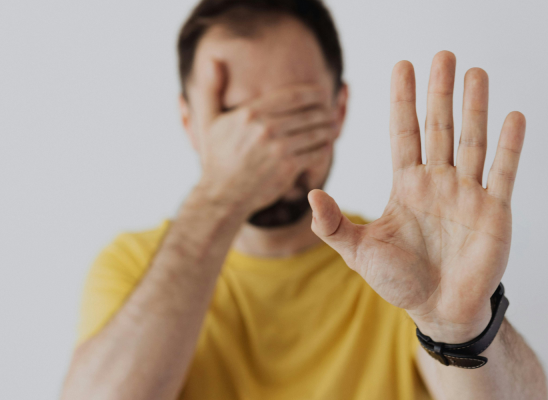
Online test
Find out the severity of your symptoms with this free online test
Both Obsessive-Compulsive Disorder (OCD) and Hoarding Disorder are complex mental disorders that are often mistaken for each other. They have historically been grouped together under the umbrella of OCD due to overlapping symptoms. However, in 2013, Hoarding Disorder was officially designated as a separate disorder with its own diagnostic criteria in the DSM 5. OCD and Hoarding Disorder are now both included in a diagnostic category known as Obsessive Compulsive and Related Disorders (OCRDs).
This new category recognizes that, despite sharing similar qualities, OCD and Hoarding Disorder have distinct features that set them apart, including differences in motivation, behavioral patterns, and underlying neurological factors. Understanding those differences is critical not only for accurate diagnosis but for effective treatment planning as well.
Understanding OCD
OCD is a mental disorder characterized by intrusive thoughts, images, or urges, known as obsessions, which cause significant anxiety or distress. To alleviate this distress, individuals engage in repetitive behaviors or mental acts, known as compulsions. For example, someone with an obsession with germs/contamination may compulsively clean their home or compulsively wash their hands to the point that it interferes with their ability to manage daily life.
This cycle of symptoms can be severe, consuming a significant portion of a person’s time and attention, and causing marked emotional distress and impaired functioning.
While estimates vary, OCD is estimated to affect about 1% to 3% of the population worldwide. It typically emerges in early adolescence, but it can develop at any age, from early childhood into adulthood.
Key symptoms of OCD include:
- Intrusive thoughts that are unwanted and cause significant anxiety or distress.
- Compulsive behaviors intended to counteract or prevent perceived threats posed by these thoughts.
- Insight into the irrationality of thoughts, though the intensity of compulsions can still feel overpowering.
The hallmark of OCD is that the person usually recognizes that their thoughts and behaviors are irrational or excessive, yet they feel compelled to perform compulsions in an effort to alleviate the distress they feel. OCD is an ego-dystonic disorder. The intrusive thoughts and compulsions that the person experiences are unwanted, distressing, and not consistent with their own values, desires, and self-perception. In short, it’s not who they are or what they want but they can’t stop.
Understanding Hoarding Disorder
Hoarding Disorder is defined by a persistent difficulty discarding or parting with possessions, regardless of their actual value. There is a perceived need to save the items and attempts to let them go results in significant distress. As a result, people with Hoarding Disorder accumulate excessive quantities of items, often rendering their living spaces unusable and sometimes, in extreme cases, uninhabitable.
The prevalence of Hoarding Disorder is estimated to be about 2.3%. Unlike OCD, Hoarding Disorder tends to emerge later in life, with an average age of diagnosis of 40. However, studies suggest that tendencies may begin to appear as early as late childhood , with some speculation that hoarding may be, for some, a lifelong characterological process. People over 60 and those with comorbid anxiety and depression seem to be at higher risk of developing hoarding behaviors.
Defining characteristics of Hoarding Disorder include:
- Strong attachment to possessions, often coupled with a belief that items may be needed or will have value in the future.
- Emotional distress when attempting to discard items, leading to avoidance of such actions.
- Impaired daily functioning due to the accumulation of clutter that limits the usability of living spaces.
- The hoarding causes clinically significant distress or impairment in social, occupational, or other important areas of functioning (including maintaining a safe environment safe for oneself or others).
Hoarding symptoms tend to be ego-syntonic. The distress in Hoarding Disorder usually comes from external pressures, such as family members or authorities urging individuals to declutter, rather than an internal compulsion to alleviate anxiety.
Hoarding Disorder vs Hoarding OCD
It’s important to note that some people have a particular type of OCD, known as Hoarding OCD, that is also distinctly different from Hoarding Disorder.
Hoarding OCD is a sub-type of OCD characterized by repetitive, intrusive thoughts surrounding the acquisition of possessions and/or discarding them. Not unlike hoarding disorder, the resulting compulsion to keep possessions can cause significant accumulation of things and disrupt the person’s ability to function in daily life.
The defining distinction between Hoarding Disorder and Hoarding OCD is the motivation behind the hoarding.
For a person with Hoarding Disorder, they accumulate things because they attach some value to them. It’s generally a behavior that is experienced as pleasurable or satisfying in some way. For example, a person with hoarding disorder might buy multiple cases of water at a time believing that the water will be valuable and needed by someone at some point.
For someone with Hoarding OCD, they accumulate things as a response to some unwanted thoughts and distress. For example, they may fear something bad will happen if they discard certain items or don’t acquire them. This accumulation of things is generally not a source of pleasure but rather a means to mitigate distress and may include ritual behaviors. Using the same water example, someone with Hoarding OCD might feel compelled to buy cases of water in multiples of three, fearing something bad will happen if they don’t.
Which disorder you have depends on the underlying dynamics rather than just the behavior itself.
Key Differences Between OCD and Hoarding Disorder
Although OCD and Hoarding Disorder share some compulsive elements, several critical distinctions separate the two disorders:
Motivation and Intent
In OCD, the primary motivation behind compulsions is to alleviate the distress that is triggered by unwanted, intrusive thought. For instance, a person with OCD may feel a need to repeatedly wash their hands to alleviate the fear of getting sick or contaminated. The compulsive behavior – in this case, handwashing, is directly linked to neutralizing a perceived threat. The intent is to relieve the distress the person is experiencing.
For someone with Hoarding Disorder, the motivation is not to alleviate anxiety from obsessive thoughts but rather to avoid the distress associated with discarding possessions. They derive positive feelings from their possessions and from adding to their collection. The items they hoard hold emotional significance or are believed to have future utility, even if they realistically serve no purpose or hold no realistic value. This attachment to possessions is typically absent in OCD.
Nature of the Compulsions
Compulsions in OCD tend to be repetitive and often ritualistic. The goal of engaging in these behaviors is to alleviate the anxiety and distress created by the unwanted, intrusive thoughts (obsessions). These compulsions are rarely associated with any realistic need or utility.
Hoarding behavior manifests as a compulsive need to acquire and retain certain items, but not in response to intrusive thoughts. In hoarding, the act of keeping items is driven by some emotional attachment, a perceived value of the items, and avoidance of the distress associated with having to discard them.
Insight and Awareness
For most people living with OCD, they have insight into the irrational nature of their thoughts and actions. They recognize that their compulsions are excessive but feel unable to control them.
People with Hoarding Disorder tend to have limited insight and often believe that their hoarding is justified and reasonable. There is no urge to remove the clutter, and they tend to experience positive emotions from their acquisition of items. This lack of awareness can make treatment more challenging, as individuals with Hoarding Disorder may not see their behavior as problematic.
Impact on Living Space
While OCD can have a profound impact on a person’s daily life and interpersonal functioning, it rarely affects their living environment in the extreme ways that Hoarding Disorder can.
In OCD, compulsions and rituals such as cleaning or organizing may temporarily disrupt household and family routine, but they rarely cause the same level of environmental impairment as hoarding.
Hoarding typically gets worse over time. It can result in severe clutter that can restrict the use of available living space. Depending on the hoard, it may pose health and safety concerns, sometimes becoming so severe that the space is rendered uninhabitable. .
Overlap and Misdiagnosis
There is some overlap between OCD and Hoarding Disorder, which can lead to misdiagnosis or a misunderstanding of symptoms. Approximately 20–30% of people with OCD exhibit some hoarding behaviors, although these behaviors are generally less severe than those seen in Hoarding Disorder.
With the DSM-5s recognition of hoarding as a distinct disorder, clinicians now have a standardized set of diagnostic criteria. Having better diagnostic tools is vital to providing accurate diagnosis and developing effective treatment plans.
Treatment Approaches: How OCD and Hoarding Disorder Differ
While they are in the same diagnostic category of OCRDs and share some similar qualities, treatment approaches for OCD and Hoarding Disorder are not the same.
OCD Treatment
Treatment for OCD usually consists of a combination of therapy and medication.
Exposure and Response Prevention (ERP), a specialized form of cognitive behavioral therapy (CBT), is the gold standard for the treatment of OCD. ERP involves gradually exposing the person to their obsessive fears without allowing them to engage in compulsions. Over time, this helps reduce the anxiety associated with the obsessions.
Medication is sometimes part of the overall treatment plan. SSRIs, such as fluoxetine (Prozac) or sertraline (Zoloft), are commonly prescribed to help reduce the severity of OCD symptoms. Medication is often most effective when combined with therapy.
If you’re diagnosed with OCD, you and your treatment provider will determine the best course of action for your unique needs.
Treating Hoarding Disorder
Treatment for Hoarding Disorder also includes CBT but the focus is different. CBT for hoarding behaviors focuses on:
- Building skills to improve decision-making, organization, and emotional regulation related to possessions
- Learning to recognize and reframe their thoughts and beliefs about possessions
- Learning how to organize possessions and practice gradually letting go of items
Unlike ERP, treatment for hoarding focuses less on exposure and more on cognitive restructuring and practical skills for managing possessions.
Success Rates for Treatment
Part of understanding the treatment of OCD and Hoarding Disorder is being realistic about treatment efficacy. While CBT and ERP are highly effective for many individuals with OCD, treating Hoarding Disorder can be more challenging.
CBT is recognized as the most well-studied approach for treating Hoarding Disorder. However, treatment outcomes are mixed. A 2015 meta-analysis found that while CBT was effective in reducing symptoms, especially discarding behavior, most participants continued to show clinically significant hoarding symptoms following treatment. In other words, they still had a hoarding disorder. Other approaches such as insight-oriented therapies, skills-based interventions, and motivational interviewing are often used to address limited insight in hoarding cases, helping clients to recognize the(MI) may be helpful.
The Takeaway: Two Distinct but Interrelated Conditions
While OCD and Hoarding Disorder share some characteristics and historically were grouped under the same diagnostic umbrella, they are distinct disorders with different motivations, symptoms, and impacts. Understanding these differences means greater insight for people living with these disorders and paves the way for more accurate diagnosis and treatment tailored to their unique needs. Personalized treatment maximizes the chances for the best possible treatment outcomes.
References
1. American Psychiatric Association. (2013). Diagnostic and statistical manual of mental disorders (5th ed.). https://doi.org/10.1176/appi.books.9780890425596
2. American Psychological Association. (n.d.). Obsessive compulsive disorder. https://www.apa.org/topics/ocd
3. Obsessive-compulsive disorder - StatPearls - NCBI bookshelf. (2023, May 29). National Center for Biotechnology Information. https://www.ncbi.nlm.nih.gov/books/NBK553162/
4. American Psychiatric Association. (2024, September). What Is Hoarding Disorder. https://www.psychiatry.org/patients-families/hoarding-disorder/what-is-hoarding-disorder
5. Dozier, M. E., Porter, B., & Ayers, C. R. (2016). Age of onset and progression of hoarding symptoms in older adults with hoarding disorder. Aging & mental health, 20(7), 736–742. https://pmc.ncbi.nlm.nih.gov/articles/PMC5612663/
6. Grisham, J. R., Frost, R. O., Steketee, G., Kim, H. J., & Hood, S. (2006). Age of onset of compulsive hoarding. Journal of anxiety disorders, 20(5), 675–686. https://pubmed.ncbi.nlm.nih.gov/16112837/
7. McGrath, P. (2023, May 26). What is it like to have OCD? Why do OCD thoughts feel so real? NOCD. https://www.treatmyocd.com/education/what-is-it-like-to-have-ocd-and-why-it-feels-real
8. Hoarding disorder. (2021, February 10). nhs.uk. https://www.nhs.uk/mental-health/conditions/hoarding-disorder/
9. Del Casale, A., Sorice, S., Padovano, A., Simmaco, M., Ferracuti, S., Lamis, D. A., Rapinesi, C., Sani, G., Girardi, P., Kotzalidis, G. D., & Pompili, M. (2019). Psychopharmacological Treatment of Obsessive-Compulsive Disorder (OCD). Current neuropharmacology, 17(8), 710–736. https://www.ncbi.nlm.nih.gov/pmc/articles/PMC7059159/
10. Hoarding disorder - Diagnosis and treatment - Mayo Clinic. (2023, January 26). Top-ranked Hospital in the Nation – Mayo Clinic. https://www.mayoclinic.org/diseases-conditions/hoarding-disorder/diagnosis-treatment/drc-20356062
11. Weir, K. (2020, April 1). Treating people with hoarding disorder. https://www.apa.org. https://www.apa.org/monitor/2020/04/ce-corner-hoarding
12. Tolin, D. F., Frost, R. O., Steketee, G., & Muroff, J. (2015). Cognitive behavioral therapy for hoarding disorder: A meta-analysis. Depression and Anxiety, 32(3), 158-166. https://doi.org/10.1002/da.22327
Online test
Find out the severity of your symptoms with this free online test
Start your journey with StopOCD
Take control of your life and find freedom from OCD through professional therapy and evidence-based cognitive behavioral techniques.
Start Now



